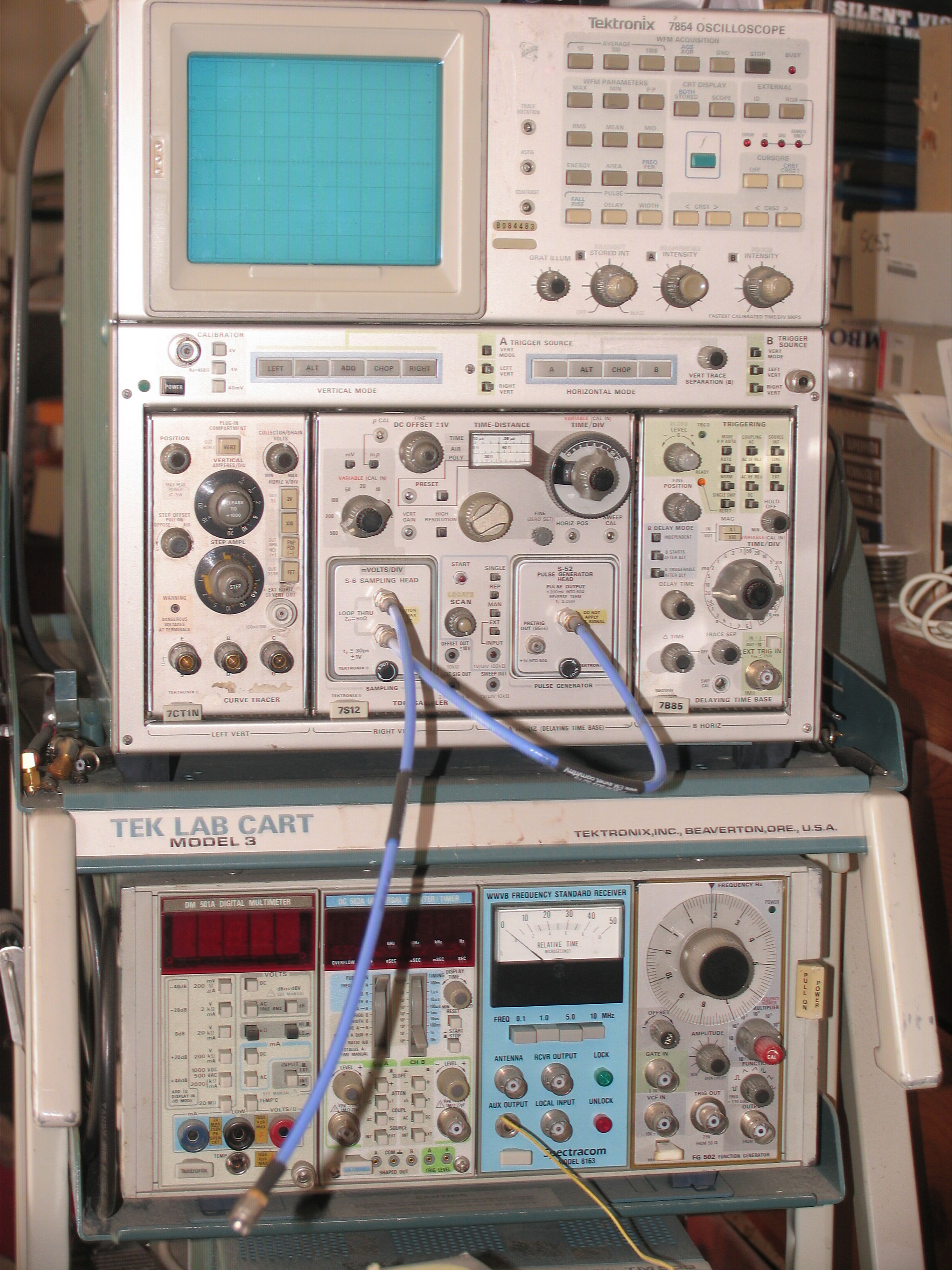|
Source Measure Unit
A source measure unit (SMU) is a type of electronic test equipment which, as the name indicates, is capable of both sourcing and measuring at the same time. Overview The source measure unit (SMU), or source-measurement unit as it is sometimes called, is an electronic instrument that is capable of both sourcing and measuring at the same time. It can precisely force voltage or current and simultaneously measure precise voltage and/or current. SMUs are used for test applications requiring high accuracy, high resolution and measurement flexibility. Such applications include I-V characterizing and testing semiconductors and other non-linear devices and materials, where sourcing voltage and current source span across both positive and negative values. To accomplish this, SMUs have four-quadrant outputs. For characterization purposes SMUs are bench instruments similar to a curve tracer. They are also commonly used in automatic test equipment and usually are equipped with an interface su ... [...More Info...] [...Related Items...] OR: [Wikipedia] [Google] [Baidu] |
Electronic Test Equipment
Electronic test equipment is used to create signals and capture responses from electronic devices under test (DUTs). In this way, the proper operation of the DUT can be proven or faults in the device can be traced. Use of electronic test equipment is essential to any serious work on electronics systems. Practical electronics engineering and assembly requires the use of many different kinds of electronic test equipment ranging from the very simple and inexpensive (such as a test light consisting of just a light bulb and a test lead) to extremely complex and sophisticated such as automatic test equipment (ATE). ATE often includes many of these instruments in real and simulated forms. Generally, more advanced test gear is necessary when developing circuits and systems than is needed when doing production testing or when troubleshooting existing production units in the field. Types of test equipment Basic equipment The following items are used for basic measurement of voltages, cu ... [...More Info...] [...Related Items...] OR: [Wikipedia] [Google] [Baidu] |
Source Sink
Source may refer to: Research * Historical document * Historical source * Source (intelligence) or sub source, typically a confidential provider of non open-source intelligence * Source (journalism), a person, publication, publishing institute or other record or document that gives information * Source document, a document in which data collected for a clinical trial is first recorded * Source text, in research (especially in the humanities), a source of information referred to by citation ** Primary source, a first-hand written evidence of history made at the time of the event by someone who was present ** Secondary source, a written account of history based upon the evidence from primary sources ** Tertiary source, a compilation based upon primary and secondary sources * Sources (website), a directory of expert contacts and media spokespersons * Open source, a philosophy of dissemination of intellectual products Law * Sources of international law, the materials and processes ou ... [...More Info...] [...Related Items...] OR: [Wikipedia] [Google] [Baidu] |
Semiconductor Curve Tracer
A semiconductor curve tracer (also known as a semiconductor parameter analyzer) is a specialised piece of electronic test equipment used to analyze the characteristics of discrete semiconductor devices such as diodes, transistors, and thyristors. Based on an oscilloscope, the device also contains voltage and current sources that can be used to stimulate the device under test (DUT). Operation The function is to apply a swept (automatically continuously varying with time) voltage to two terminals of the device under test, and measuring the amount of current that the device permits to flow at each voltage. This so-called V-I (voltage versus current) graph is displayed on an oscilloscope screen. Configuration includes the maximum voltage applied, the polarity of the voltage applied (including the automatic application of both positive and negative polarities), and the resistance inserted in series with the device. The main terminal voltage can often be swept up to several thousand ... [...More Info...] [...Related Items...] OR: [Wikipedia] [Google] [Baidu] |
Automatic Test Equipment
Automatic test equipment or automated test equipment (ATE) is any apparatus that performs tests on a device, known as the device under test (DUT), equipment under test (EUT) or unit under test (UUT), using automation to quickly perform measurements and evaluate the test results. An ATE can be a simple computer-controlled digital multimeter, or a complicated system containing dozens of complex test instruments (real or simulated electronic test equipment) capable of automatically testing and diagnosing faults in sophisticated electronic packaged parts or on wafer testing, including system on chips and integrated circuits. Where it is used ATE is widely used in the electronic manufacturing industry to test electronic components and systems after being fabricated. ATE is also used to test avionics and the electronic modules in automobiles. It is used in military applications like radar and wireless communication. In the semiconductor industry Semiconductor ATE, named for testing se ... [...More Info...] [...Related Items...] OR: [Wikipedia] [Google] [Baidu] |
IEEE-488
IEEE 488 is a short-range digital communications 8-bit parallel multi-master interface bus specification developed by Hewlett-Packard as HP-IB (Hewlett-Packard Interface Bus). It subsequently became the subject of several standards, and is generically known as GPIB (General Purpose Interface Bus). Although the bus was created in the late 1960s to connect together automated test equipment, it also had some success during the 1970s and 1980s as a peripheral bus for early microcomputers, notably the Commodore PET. Newer standards have largely replaced IEEE 488 for computer use, but it is still used by some test equipment. Origins In the late 1960s, Hewlett-Packard (HP) manufactured various automated test and measurement instruments, such as digital multimeters and logic analyzers. They developed the ''HP Interface Bus (HP-IB)'' to enable easier interconnection between instruments and controllers (computers and other instruments). The bus was relatively easy to implemen ... [...More Info...] [...Related Items...] OR: [Wikipedia] [Google] [Baidu] |
Universal Serial Bus
Universal Serial Bus (USB) is an industry standard that establishes specifications for cables, connectors and protocols for connection, communication and power supply (interfacing) between computers, peripherals and other computers. A broad variety of USB hardware exists, including 14 different connector types, of which USB-C is the most recent and the only one not currently deprecated. First released in 1996, the USB standards are maintained by the USB Implementers Forum (USB-IF). The four generations of USB are: USB 1.''x'', USB 2.0, USB 3.''x'', and USB4. Overview USB was designed to standardize the connection of peripherals to personal computers, both to communicate with and to supply electric power. It has largely replaced interfaces such as serial ports and parallel ports, and has become commonplace on a wide range of devices. Examples of peripherals that are connected via USB include computer keyboards and mice, video cameras, printers, portable media players, ... [...More Info...] [...Related Items...] OR: [Wikipedia] [Google] [Baidu] |
Current Source
A current source is an electronic circuit that delivers or absorbs an electric current which is independent of the voltage across it. A current source is the dual of a voltage source. The term ''current sink'' is sometimes used for sources fed from a negative voltage supply. Figure 1 shows the schematic symbol for an ideal current source driving a resistive load. There are two types. An ''independent current source'' (or sink) delivers a constant current. A ''dependent current source'' delivers a current which is proportional to some other voltage or current in the circuit. Background , - align="center" , style="padding: 1em 2em 0;", , style="padding: 1em 2em 0;", , - align="center" , Voltage source , Current source , - align="center" , style="padding: 1em 2em 0;", , style="padding: 1em 2em 0;", , - align="center" , Controlled voltage source , Controlled current source , - align="center" , style="padding: 1em 2em 0;", , style="padding: 1em 2em 0;", , - align ... [...More Info...] [...Related Items...] OR: [Wikipedia] [Google] [Baidu] |
Voltage Source
A voltage source is a two-terminal device which can maintain a fixed voltage. An ideal voltage source can maintain the fixed voltage independent of the load resistance or the output current. However, a real-world voltage source cannot supply unlimited current. A voltage source is the dual of a current source. Real-world sources of electrical energy, such as batteries and generators, can be modeled for analysis purposes as a combination of an ideal voltage source and additional combinations of impedance elements. Ideal voltage sources An ideal voltage source is a two-terminal device that maintains a fixed voltage drop across its terminals. It is often used as a mathematical abstraction that simplifies the analysis of real electric circuits. If the voltage across an ideal voltage source can be specified independently of any other variable in a circuit, it is called an independent voltage source. Conversely, if the voltage across an ideal voltage source is determined by ... [...More Info...] [...Related Items...] OR: [Wikipedia] [Google] [Baidu] |
Four-terminal Sensing
Four-terminal sensing (4T sensing), 4-wire sensing, or 4-point probes method is an electrical impedance measuring technique that uses separate pairs of current-carrying and voltage-sensing electrodes to make more accurate measurements than the simpler and more usual two-terminal (2T) sensing. Four-terminal sensing is used in some ohmmeters and impedance analyzers, and in wiring for strain gauges and resistance thermometers. Four-point probes are also used to measure sheet resistance of thin films (particularly semiconductor thin films). Separation of current and voltage electrodes eliminates the lead and contact resistance from the measurement. This is an advantage for precise measurement of low resistance values. For example, an LCR bridge instruction manual recommends the four-terminal technique for accurate measurement of resistance below 100 ohms.Manual for the Racal-Dana Databridge 9343M: "If the resistance value is low, less than 100 ohms, make a four-terminal connection. ... [...More Info...] [...Related Items...] OR: [Wikipedia] [Google] [Baidu] |
Voltage Source
A voltage source is a two-terminal device which can maintain a fixed voltage. An ideal voltage source can maintain the fixed voltage independent of the load resistance or the output current. However, a real-world voltage source cannot supply unlimited current. A voltage source is the dual of a current source. Real-world sources of electrical energy, such as batteries and generators, can be modeled for analysis purposes as a combination of an ideal voltage source and additional combinations of impedance elements. Ideal voltage sources An ideal voltage source is a two-terminal device that maintains a fixed voltage drop across its terminals. It is often used as a mathematical abstraction that simplifies the analysis of real electric circuits. If the voltage across an ideal voltage source can be specified independently of any other variable in a circuit, it is called an independent voltage source. Conversely, if the voltage across an ideal voltage source is determined by ... [...More Info...] [...Related Items...] OR: [Wikipedia] [Google] [Baidu] |
Current Source
A current source is an electronic circuit that delivers or absorbs an electric current which is independent of the voltage across it. A current source is the dual of a voltage source. The term ''current sink'' is sometimes used for sources fed from a negative voltage supply. Figure 1 shows the schematic symbol for an ideal current source driving a resistive load. There are two types. An ''independent current source'' (or sink) delivers a constant current. A ''dependent current source'' delivers a current which is proportional to some other voltage or current in the circuit. Background , - align="center" , style="padding: 1em 2em 0;", , style="padding: 1em 2em 0;", , - align="center" , Voltage source , Current source , - align="center" , style="padding: 1em 2em 0;", , style="padding: 1em 2em 0;", , - align="center" , Controlled voltage source , Controlled current source , - align="center" , style="padding: 1em 2em 0;", , style="padding: 1em 2em 0;", , - align ... [...More Info...] [...Related Items...] OR: [Wikipedia] [Google] [Baidu] |




